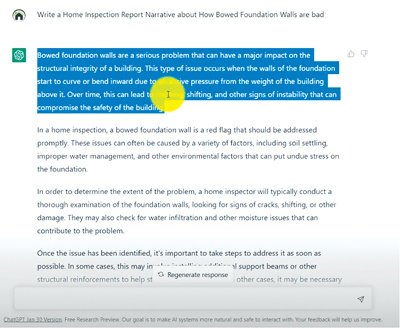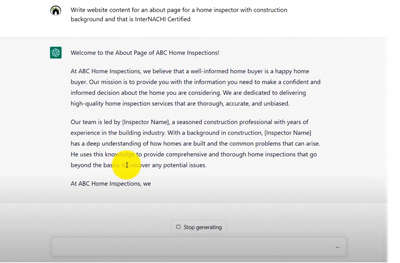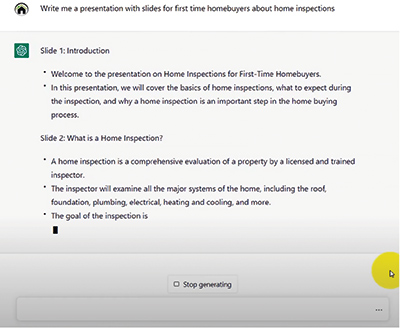 | > E&O/GL Insurance for Home Inspectors Competitive Rates, Broad Coverage, Free Risk Management, online inspection support for tough questions, discounts on education and more… Professional Coverage, Competitive Pricing Shop OREP today! |
Make Use of ChatGPT
By Ian Robertson, Inspector Toolbelt
We may not be sitting around wondering how AI (Artificial Intelligence) may affect our industry as home inspectors—but we probably should be.
AI is changing how the world works, and it is also changing how our industry works. The primary service out there that is changing things is called ChatGPT (Chat.openai.com/chat). This is similar to when electronic reports, infrared cameras, and other tools came into play. This service is just that—a tool. And if we don’t use it, we will get left behind. So what is ChatGPT and how can we use it?
What is ChatGPT?
ChatGPT is an artificial intelligence, text-based chatbot. If you ask it to write something or tell us something, it will formulate a response with text. It can answer questions, compile lists, and generate paragraphs of writing. It is extremely useful and complex and will likely revolutionize how we do business.
There are three ways that we will discuss how home inspectors can utilize this tool. These three ways are: writing report narratives, writing website content, and writing newsletters and presentations. So, let’s discuss the first way we can use ChatGPT: writing reports.
1. Writing Reports
Before you start to worry that you will be replaced, let’s put your mind at ease. ChatGPT is not taking over the home inspection industry. Think of this as a great supplemental tool instead of something that is going to write your whole report. And it will save you time, especially if you are new to home inspections.
For example, let’s say you inspected a house with a bowed foundation wall. You could type in something like, “Write a home inspection report narrative about how bowed foundation walls are bad.” As shown in Figure 1, you can see that ChatGPT will generate a narrative. But you may notice that it is overly objective. It does not identify the issue. That is up to the inspector. And it does not give an opinion. Those are limitations of AI.
You can begin your report by writing something like, “Bowed foundation wall noted at the west side of the home. Recommend evaluation by a qualified contractor because a bowed foundation wall can be a serious issue. Here’s why.” Then, from what ChatGPT generated, you might want to choose a portion of what’s written. Sometimes it writes way more than you need or is a bit wordy. So, you can select bits and pieces from it (See Figure 1: Home Inspection Report on Bowed Foundation Wall).

Figure 1: Home Inspection Report on Bowed Foundation Wall
Enlarged Image
Explaining why something is bad is oftentimes where we lack the ability, especially as new inspectors, to write a good narrative. And it’s probably the longest part of our report. ChatGPT can really help with that. But you do have to read thoroughly what it generates. The information may not always be correct. If you do not know some information, don’t rely on ChatGPT to give you the answer. ChatGPT is not a replacement for a home inspector’s knowledge and responsibility.
If you don’t like a response given by ChatGPT, you can have it regenerate a new response. And remember that it matters how you ask it. For example, instead of writing, “Write a home inspection report narrative about how bowed foundation walls are bad,” if you just asked it “Write a narrative about how bowed foundation walls are bad,” you might get a funny story about a bowed wall, not something you would use in an inspection report. Or if you ended it with how the bowed foundation walls are “serious” instead of “bad,” then you won’t get the opinion you may be looking for. “Serious” can mean many different things. You need to give AI an opinion to work with.
(story continues below)
(story continues)
2. Writing Content
Perhaps you are thinking of making your own website, or you have a website and want to write blogs to help your SEO. Coming up with written content may take a lot of work. When our team at Full View creates websites for clients, we notice that the hardest information to get is often a description for the About Us page of their website. People don’t like talking about themselves. So if you are trying to do this, ChatGPT can help. For blogs, you can ask it, for example, “Write a unique 150-word blog on doorknobs,” and it will create the blog within a few seconds (See Figure 2: Written Web Content).

Figure 2: Written Web Content
Enlarged Image
Let’s address some misconceptions about AI that people have. Some people say that you should avoid using AI because Google hates AI content and will penalize your website if it includes such. None of that is true. First of all, Google has stated that it has accepted AI content for years. Here is a quote from Danny Sullivan, public liaison for Google Search: “Our focus on the quality of content, rather than how content is produced, is a useful guide that has helped us to deliver reliable, high-quality results to users for years.” Google also says, “Automation has long been used to generate helpful content such as sports scores, weather forecasts and transcripts.”
One of the things that Google did recently was come out with what is called the helpful content algorithm update. So what that means is, it doesn’t care where the content comes from, as long as it’s helpful. If you write bad content as a human, and AI writes helpful content, Google will assist that AI-generated helpful content to gain a higher ranking than your human-written content. Google cares that content is unique and helpful.
3. Writing Newsletters and Presentations
ChatGPT can help you quickly make presentations (See Figure 3: Slide Presentation Content). It won’t create images, but you can use Dall-E for that (Labs.openai.com/). But it can write you all the wording for a slide presentation. For example, you are holding a first-time homebuyer seminar and need an outline. Give ChatGPT specific instructions like, “Write me a presentation with slides for first-time homebuyers about home inspections.” And watch it generate your slides. Make some tweaks here and there, but overall, it will save you time and mental energy.
The same thing goes for newsletters. You could tell ChatGPT, “Write an email newsletter about spring maintenance.” And it will. You don’t have to hire an outside company to write them.

Figure 3: Slide Presentation Content
Enlarged Image
Using ChatGPT Is Beneficial
There are many other uses for ChatGPT that we haven’t covered in this article. But these three that we discussed, writing reports, content, newsletters, and presentations, are some that you should really consider using ChatGPT for. It can be a useful tool for any home inspector and get you ahead in the game. Just remember to check for inaccuracies and verify the data. Insert idioms here and there (as it does not know how), and use real speech with opinions. Try it today. Go to Chat.openai.com.
About the Author
Ian Robertson is a veteran home inspector, owner of three inspection companies, owner of Full View Home Inspector Marketing, and one of the founders of Inspector Toolbelt. Inspector Toolbelt is simple administrative and scheduling software for home inspectors that makes running your inspection business easy and automated.
OREP Insurance Services, LLC. Calif. License #0K99465


